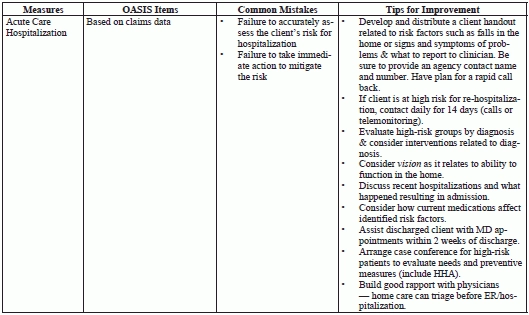Home Health Coding and OASIS Expert
Boost Your Star Ratings with these Tips
Start with a thorough assessment and good documentation.
The first step with the outcome measure items is to ensure that the assessing clinicians are answering them correctly in the first place, says Lisa Selman-Holman, JD, BSN, RN, COS-C, HCS-D, HCS-O, AHIMA Approved ICD-10-CM Trainer/Ambassador of Selman-Holman & Associates, LLC, CoDR — Coding Done Right and Code Pro University in Denton, Texas. When patients are rated too high to begin with, the patient either cannot show improvement or shows decline by discharge. Concentrate OASIS education on the items and the guidance surrounding those outcome measures first, she suggests.
There is a lot of misunderstanding surrounding the process measure items, too, Selman-Holman says. “I hear complaints such as ‘we cannot improve on influenza vaccination because our agency does not give the vaccine.’” The intent of the influenza vaccine items is to determine whether the patient received the influenza vaccine for this year’s flu season, not simply whether your agency administered the shot. Misunderstandings such as these can really hurt an agency’s outcomes, she says.
What can you do to make sure your agency receives the best possible Home Health Compare Star ratings? Look to the table below from Pat Jump with Rice Lake, Wis.-based Acorn’s End Training & Consulting for a list of some of the common mistakes that occur when answering the OASIS questions that generate your ratings. You’ll also find some tips for improving both the accuracy of OASIS answers and your HHC Star Ratings.



Home Health Coding and OASIS Expert
- ICD-10 Coding:
Know Where to Turn When Coding Neoplasms in ICD-10
Make sure you master the exceptions to the rules. Coding for neoplasms in ICD-10 isn’t [...] - Quality Measures:
Are Your OASIS Responses Costing Your Agency?
Nine measures factor into your star rating. Starting this month, prospective patients are able to [...] - Tool:
Boost Your Star Ratings with these Tips
Start with a thorough assessment and good documentation. The first step with the outcome measure [...] - Assessment:
Don't Overlook Coordination at End of Episode
Take time to update the 485 for recerts. Many home health agencies struggle with coordination [...]

